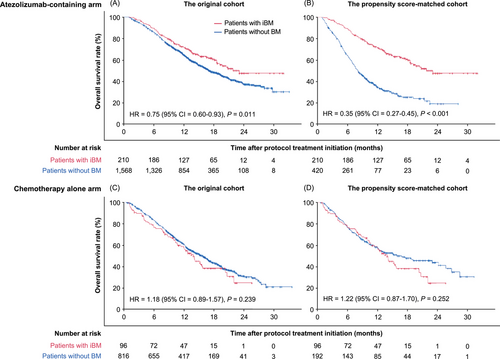Association of previously irradiated stable brain metastases with outcomes of atezolizumab-treated non-small cell lung cancer: A pooled analysis of individual patient data from three randomized trials
Tiantian Guo and Yue Zhou contributed equally to this work.
List of abbreviations
-
- BM
-
- brain metastasis
-
- ECOG PS
-
- Eastern Cooperative Oncology Group performance status
-
- PD-L1
-
- programmed death ligand-1
-
- NSCLC
-
- Non-small cell lung cancer
-
- OS
-
- overall survival
-
- PFS
-
- progression-free survival
-
- iBM
-
- previously irradiated stable BM
-
- PD-1/PD-L1
-
- Programmed death 1/programmed death-ligand 1
-
- PSM
-
- propensity score matching
-
- HR
-
- Hazard Ratio
-
- CI
-
- confidence interval
-
- AEs
-
- adverse events
Brain metastasis (BM) has long been recognized as a prognostic factor associated with poor prognosis for non-small cell lung cancer (NSCLC) in the era of conventional chemotherapy and targeted therapy [1]. In the era of immunotherapy, controversial findings have been reported regarding the prognostic significance of BM in patients with NSCLC treated with programmed death-1/programmed death-ligand 1 (PD-1/PD-L1) inhibitors. Several studies have shown that the presence of BM did not impact overall survival (OS) or progression-free survival (PFS) [2, 3], whereas other studies have identified BM as a negative prognostic factor [4, 5]. These previous works were mostly based on small sample sizes, and the prognostic significance of BM in patients treated with PD-1/PD-L1 inhibitors warrants further investigation.
In the present study, we used Vivli, a global, neutral data-sharing platform that enables access to anonymized individual patient data from trials, to evaluate the association between previously irradiated stable BM (iBM) and treatment outcomes of atezolizumab-containing regimens using pooled data from prospective phase III trials. Three clinical trials, IMpower130 (NCT02367781) [6], IMpower131 (NCT02367794) [7], and IMpower150 (NCT02366143) [8], were identified. Supplementary Table S1 provides an overview of the included three clinical trials. The study design and methods are described in the Supplementary Material.
Supplementary Figure S1 shows the patient disposition for the per-protocol population. In the per-protocol population (n = 2,700), only 10 (3.3%) of 316 patients with baseline BM did not undergo previous irradiation, who were excluded due to difficulties in statistical analyses. Among the 2,690 patients finally included, 210 (11.8%) of 1,778 patients in the atezolizumab-containing arm and 96 (10.5%) of 912 patients in the chemotherapy alone arm had iBM. Baseline demographics and clinical characteristics for patients without baseline BM and patients with iBM are shown in Supplementary Table S2. In patients without BM, OS and PFS were improved with atezolizumab-containing regimens compared with chemotherapy alone (Supplementary Figure S2). In patients with iBM, adding atezolizumab significantly improved OS and PFS compared with chemotherapy alone (Supplementary Figure S3).
We utilized propensity score matching (PSM) to control for the heterogeneity between patients with iBM and those without BM (Supplementary Table S3). A total of 11 patients in the atezolizumab-containing arm and 10 in the chemotherapy alone arm were excluded due to missing relevant baseline characteristic data. We compared the OS of patients with iBM and those without baseline BM before and after PSM (Figure 1). In the atezolizumab-containing arm, OS was longer in patients with iBM than in those without BM in the original cohort (unadjusted hazard ratio [HR] = 0.75, 95% confidence interval [CI] = 0.60-0.93, P = 0.011; adjusted HR = 0.75, 95% CI = 0.60–0.95, P = 0.015; Supplementary Table S4) and the propensity score-matched cohort (unadjusted HR = 0.35, 95% CI = 0.27-0.45, P < 0.001; adjusted HR = 0.26, 95% CI = 0.20–0.33, P < 0.001; Supplementary Table S5); in the chemotherapy alone arm, OS was similar between patients with iBM and those without BM in the original cohort and the propensity score-matched cohort. There was a significant interaction between treatment arms and BM status before and after PSM (Pinteraction = 0.013, Pinteraction < 0.001, respectively). We also applied stabilized inverse probability weighting and obtained similar results (Supplementary Table S6 and Supplementary Figure S4). We also compared the PFS of patients with iBM and those without baseline BM, and the results are shown in Supplementary Figures S5-S6 and Supplementary Tables S7-S10.

Kaplan-Meier plot of overall survival of patients with previously irradiated BM versus those without BM. Comparison of patients randomized to the atezolizumab-containing arm with previously irradiated BM and those without baseline BM in the original cohort (A) and the propensity score-matched cohort (B). Comparison of patients randomized to the chemotherapy alone arm with previously irradiated BM and those without baseline BM in the original cohort (C) and the propensity score-matched cohort (D).
Abbreviations: BM, brain metastasis; iBM, previously irradiated stable BM; CI, confidence interval; HR, hazard ratio.
Furthermore, we compared the OS and PFS between patients without BM and patients with iBM who had radiotherapy technique information available and found that radiosurgery-treated stable BM or whole-brain radiotherapy-treated stable BM was associated with improved survival in the atezolizumab-containing arm after PSM, but not in those in the chemotherapy alone arm (Supplementary Figures S7-S10).
Atezolizumab-related neurological adverse events (AEs) of any grade occurred in 225 patients (14.3%) without baseline BM and 31 patients (14.8%) with iBM; atezolizumab-related grade 3/4 neurological AEs were reported in 19 patients (1.2%) without BM and 4 patients (1.9%) with iBM (Supplementary Table S11). The rates of atezolizumab-related serious neurological AEs were similar between patients without BM and patients with iBM (0.7% vs. 0.4%). The most common atezolizumab-related neurological AE was headache in patients without baseline BM and neuropathy peripheral in patients with iBM (Supplementary Table S12).
A unique feature of the present study compared to previous investigations is that all of the included patients with BM had previously received irradiation and had stable BM, whereas previous works included a heterogeneous group of BMs, including active BM, non-irradiated stable BM, and irradiated stable BM. Therefore, our findings hint at the possibility of the interaction of cranial radiotherapy with the immune system to augment anti-tumor immunity. Atezolizumab-containing chemoimmunotherapy combination has shown promising efficacy in NSCLC patients without BM. The better survival outcomes observed in patients with iBM who received atezolizumab-containing chemoimmunotherapy combination compared to those without BM may be due to the potential synergistic anti-tumor effects of cranial radiotherapy and atezolizumab. Cranial radiotherapy may have immunogenic effects on the tumor microenvironment of the brain, causing immunogenic cell death and the release of tumor antigens, which in turn activates immune cells. This immunogenic effect within the brain has the potential to enhance the systemic immune response to atezolizumab, leading to a more effective overall immune response. Further studies investigating if and how cranial radiotherapy could be a potential game-changer to prime a more effective systemic anti-tumor response to anti-PD-1/PD-L1 therapy for patients with BM are warranted.
There were some limitations of the present study. First, the small sample size of patients with non-irradiated BM did not allow for statistical comparisons of OS and PFS between patients with non-irradiated BM and those with iBM. It is worth mentioning that the presence of BM has been reported to have a negative prognostic impact or no significant effect on PFS or OS in patients with advanced NSCLC treated with PD-1/PD-L1 inhibitors [2-5, 9, 10]. In this regard, the significant survival benefit of patients with iBM compared to those without BM in the atezolizumab-containing arm is especially notable.
Second, since cranial radiotherapy was performed prior to enrollment, information on radiotherapy techniques was not available for 9.0% and 14.6% of the patients in the atezolizumab-containing arm and chemotherapy alone arm, respectively.
Third, this analysis was based on patients with treated stable BM. The prognostic significance of active BM in the era of immunotherapy is largely unknown since patients with active BM are excluded in almost all of the clinical trials. Additionally, the three trials included in the present study utilized different therapeutic agents in addition to atezolizumab, which could potentially introduce a confounding factor.
Overall, our results suggest that previously irradiated stable BM was associated with improved outcomes in patients who received atezolizumab-containing regimens. These data lend credence to the notion that even though anti-PD-1/PD-L1 therapy has activity against BM, patients may benefit from having cranial radiotherapy prior to anti-PD-1/PD-L1 therapy. Our findings also highlight the need to explore whether cranial radiotherapy can improve systemic responses to immunotherapy in patients with BM from NSCLC.
DECLARATIONS
AUTHOR CONTRIBUTIONS
Study conception and design: TG, JN, ZZ. Data acquisition: TG, JN, ZZ, YZ. Data analyses: TG, JN, FL, ZW. Data interpretation: all authors; contribution to and approval of manuscript: all authors.
ACKNOWLEDGEMENTS
This publication is based on research using data from Roche that has been made available through Vivli, Inc. Vivli has not contributed to nor approved, and is not in any way responsible for, the contents of this publication. The authors appreciate the academic support from AME Lung Cancer Collaborative Group.
CONFLICT OF INTERESTS STATEMENT
None declared.
FUNDING INFORMATION
Chinese Society of Clinical Oncology (Y-BM2019-082, Y-MSD2020-0147), Science and Technology Commission of Shanghai Municipality (20Y11913500).
PATIENT CONSENT FOR PUBLICATION
Not required.
ETHICS APPROVAL AND CONSENT TO PARTICIPATE
This study was deemed negligible risk research and exempt from review by the Ethical Committees of Fudan University Shanghai Cancer Center.
Open Research
DATA AVAILABILITY STATEMENT
The data presented in the study are from Roche that has been made available through Vivli, Inc (https://vivli.org/). Interested groups may complete a Vivli Data Request Form on https://vivli.org/resources/resources/, which will be submitted to all relevant Data Contributors for review, according to the Data Contributor's data sharing policies and criteria.




